I’ve had my second chance to take Neil Thomas' One Hour Wargames out for a test drive. The executive summary of my thoughts as processed through my many biases: great scenarios, but only ok games.
I tried an early scenario (#4, I think) where both Red and Blue start off the board, with a river in the middle. Red and Blue both get six units, determined randomly. The objective at the end of fifteen turns is for one side to control both the bridge and the ford. Here’s my appropriately simple table. Besides the river with the two crossing points, the only terrain items Neil calls for are a hill SW and a forest NE. I added some fields because the poor old table looked so naked.
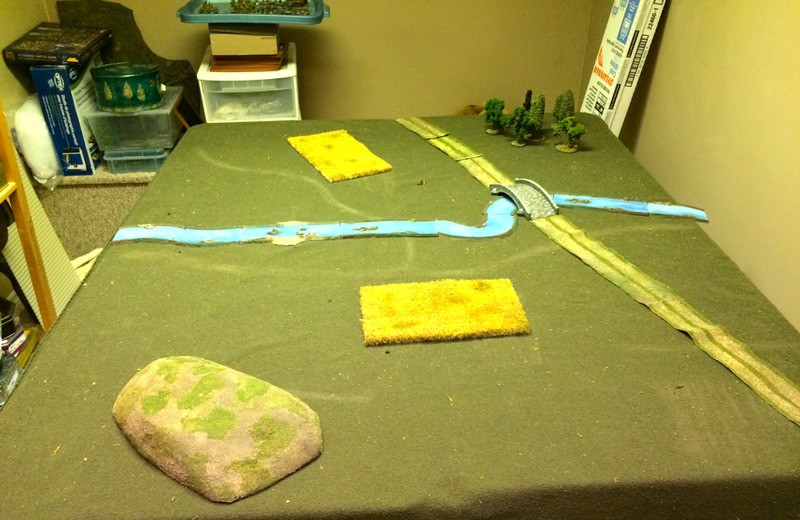
For this battle I decided that my 20mm WW2 kit would make a nice change from the medieval battle I tried last time with OHW. Red (of course) are the Soviets. For them I rolled 1 tank 1 AT gun, and four infantry. Blue (German) get 1 tank, 1 mortary, and four infantry. Because I was using a bigger table than the 3’ by 3’ that OHW calls for, I doubled the movement and range distances. Here the Russian tank has reached the ford, while the AT gun approaches the bridge. Three Russian infantry groups in the open, and one in the woods top right. Germans brace to meet them.
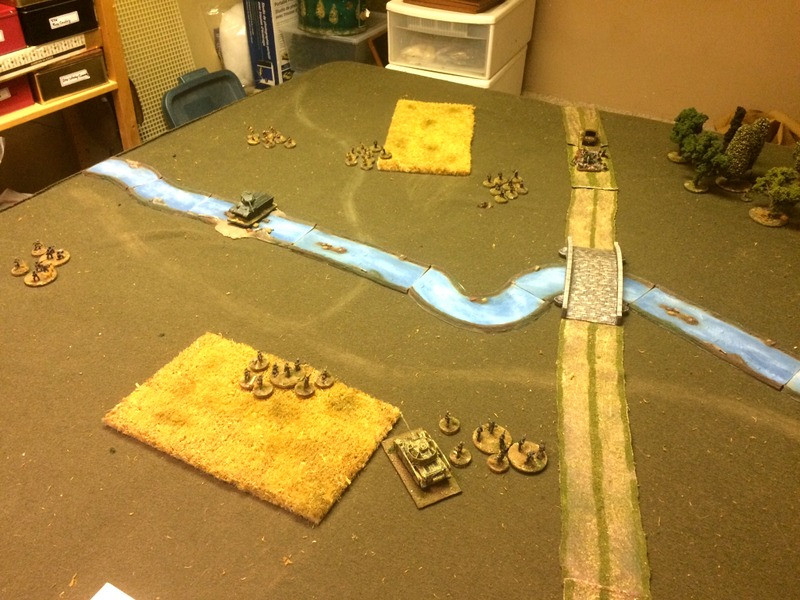
Russian AT gun moves up to the stream, while infantry rush across the bridge. Notice my brave Naval Infantry leading the way. That gun looks suspiciously like it belongs in the Fall of Berlin, not out by this lovely stream.
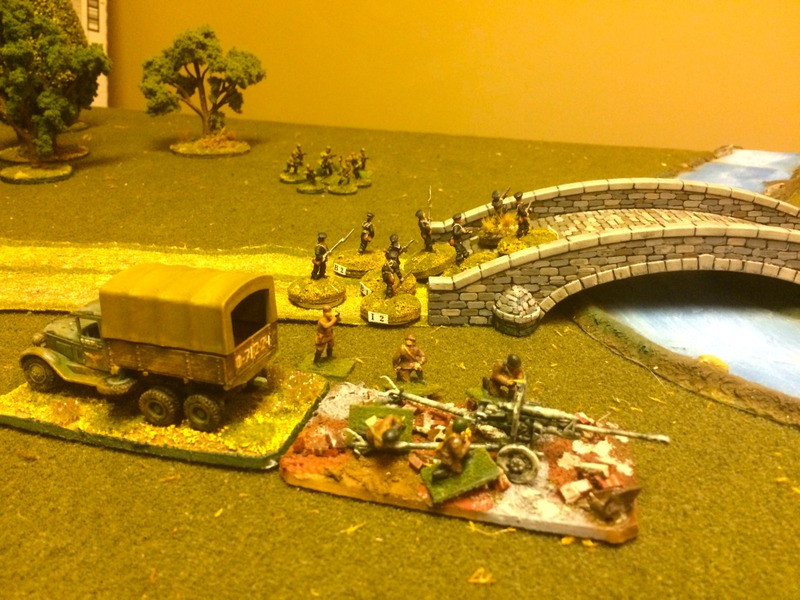
Russians taking fire. 15 hits on a unit eliminates it. Combat in OHW is brutally simple. Each shooting unit rolls a dice and adds or subtracts modifiers, thus generating the number of hits. For example, infantry vs tank roll 1d6 -2. Tank vs tank roll 1d6 +2. The Soviet infantry are also getting hammered by the German mortars, 1d6+2 vs infantry, while the T34 is getting roughed up by the PZIV and the supporting infantry.
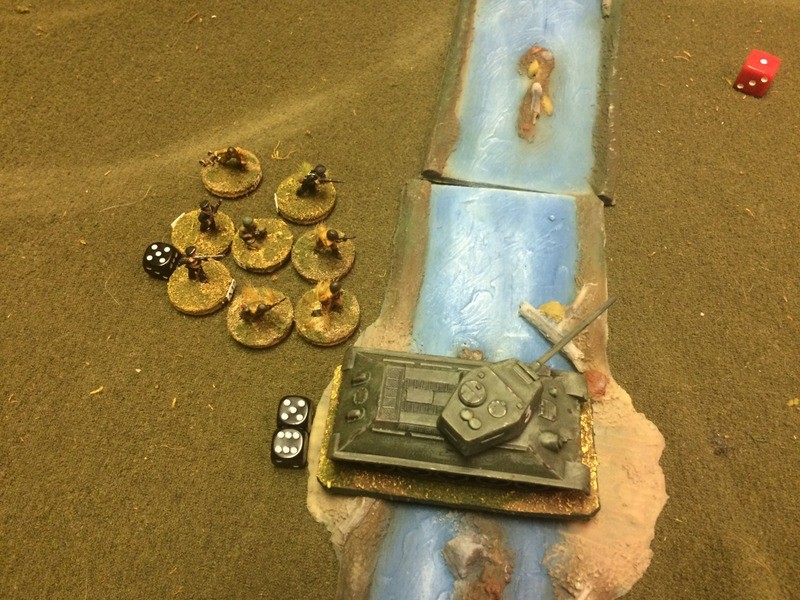
But the Jerry tank is KOed by the T34 and AT gun, while Soviets rush over the bridge. That tank, by the way, is a Britannia resin model I splashed out on a few years back, and very nice it is.

Casualties mount as the infantry duke it out. The naval infantry did their job as bullet magnets and allowed the supporting squad to cross the stream.
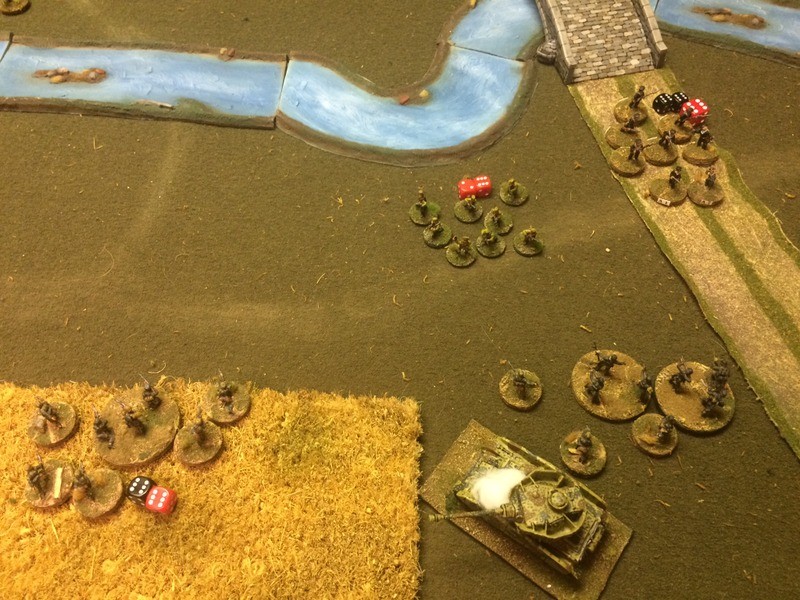
With two hits remaining to it, the T34 (an Armourfast model) charges the hill occupied by the mortars (represented by the command figure) only to be KOed by a lucky shot from the infantry in the background.

Game ended on Turn 9 with all German infantry wiped out, and two surviving Russian infantry racing for the hill to take out the mortars. I decided it was a Russian victory.
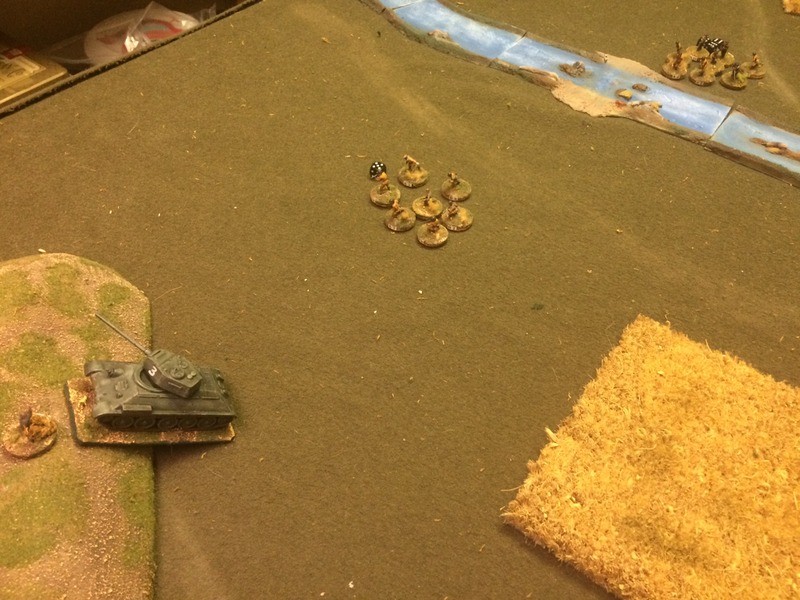
So an enjoyable game, and easily played in a hour. It would be churlish to say anything bad about a rules set that aims to deliver a complete game in 2-3 pages. So, if one wants a game with:
1) No leadership rules
2) No morale rules - you fight to the last man
3) No troop quality rules - everyone fights the same
4) No range effects - units shoot the same at long range and short range
5) No casualty effetcs - units fight as well with all 15 hit points or with only 1 remaining
… then this game is for you. I also have to say that I didn’t find the WW2 game that different from the medieval game I played. Both felt slightly generic.
However, as I said, I am being churlish. The book delivers short, playable games that would be good introductions to the hobby to newcomers and young people, and I suspect have some tactical complexity that I have not yet begun to appreciate. I could even see a niche subset of tournament games using these rules. More importantly, OHW delivers an excellent supply of scenarios, and as I’ve said here before, I really really suck at designing good scenarios.
Having set up this board, I decided to use it and the control the river crossings to revisit my favourite tactical level WW2 rules, Chain of Command. This is to do my bit in Too Fat Lardies’ Chain of Command Challenge for September. I kept it as Soviets vs Germans, but made the table a little sexier to reflect a more tactical environment. If you wish, you can follow my progress on Twitter, as I will be tweeting updates as time permits. Follow me at @madpadre1 or by hashtag #spreadthelard. I’ll do a complete report here when the dust settles.
Blessings to your die rolls!
MP

You'll have to forgive me as I don't Tweet, but I do look forward to reading the full report here thereafter.
ReplyDeleteOHW seems perfect to get my 10-year-old into a game. And 3'x3' playing surface can be done on the kitchen table. Not something I'll be playing against my regular opponents though.
When my children were pre-teens I had several games with them using rules I made up more or less on the spot, much like OHW in terms of complexity. Those remain some of the best games I've ever played.
DeleteIt seems to me the scenario you chose doesn't really offer much room for guile and subtlety - especially for a WW2 game - unless the forces drawn a very disparate. I thought as I read your narrative that it was possibly unfortunate that the contending forces were so similar in composition. It might be worth a revisit, or some some tweaking maybe.
ReplyDeleteI rather think by the sound of it I would prefer a bit more complexity in my rule sets. I call my Army Men rule set (still developing - have to sort out close combat and morale) a 'one brain cell' set, but it is certainly more complicated than OHW. Maybe I should rethimk!
Ion: From what I've seen of your horse and musket rules, and what I would expect from your Army Men rules, I would say OHW is the first rung on the ladder of wargaming complexity (well, maybe second rung, if shooting/throwing objects at figures to knock them over, a la HG Wells, is the first rung). I suspect you are at least a third of the way up the ladder. And, as with a ladder, you may not need to get to the very top, but you need every rung between the ground and where you need to be. :)
DeleteThanks for the quick review- the blogosphere seems to be fairly mixed on the book. If I see a copy I deem cheap enough I probably will pick it up. Am more tempted with his 19th century rules that I saw at the week end- have you any thoughts on those?
ReplyDeleteGood look with that CoC game- the table definately needs more terrain on it.
Cheers,
Pete.
If Michael does not mind, I will interject my thoughts...
DeletePete, I have yet to play Thomas' 19th Century rules but the book is first rate and the content an enjoyable read and provides valuable insight into the author's design theory. If you have an interest in the period, I recommend grabbing the book. If you don't like what you see in it, send it on to me and I will buy your copy. No risk to you!
I have a review of the rules on my blog, at
http://palousewargamingjournal.blogspot.com/2012/10/review-thomas-wargaming-19th-century.html if you are interested in a broad overview of the mechanisms.
I have been meaning to get a game in using these rules but have not managed that activity yet.
Thanks for the offer- very decent of you. I will pick up a copy and see what I make of it.
DeleteCheers,
Pete.
Michael, OHW certainly is a Fast Play set of rules. To borrow from the Archduke above, OHW really is a one brain cell set of rules. As in most things, beauty is in the eye of the beholder or in this case what the game want from a set of rules? Having only played one game myself, my play did not evolve to the level of surfacing tactical nuances. Fast play, great for an introduction but I think I prefer a little more meat on the bones. Of course, I will give it some more play.
ReplyDeleteThanks for the review! I bought the book because of the scenarios, which are great, but I haven't yet tried the rules. I like the minimalistic approach as a lesson in rules design, but I guess you're right: I wouldn't want to play such games regularly.
ReplyDeleteI bought the book when it first came out, played some solo games, then gave it up. Far too simple, resulting in no real sense of 'gaming' at all. As you say, games feel generic, with period feel absent.
ReplyDeleteTake your favourite set of rules, restrict yourself to 6 units a side, use a 3' x 3' table, and you'll have a 1 hour game that's much better.
Mike, I can see your objection and to be honest, it's probably why I didn't go near the One Hour Wargame book. Most of my wargames are about an hour at this stage anyway, because Command & Colours gives me that experience, but with far more tactical nuance.
ReplyDeleteThat said, it seemed unkind to criticise an apple for not being an orange. NT is capable of producing really good stuff, his book on 19th century Europe is tip top.